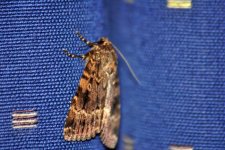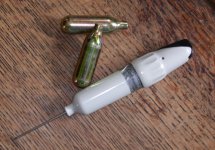-
Welcome to BirdForum, the internet's largest birding community with thousands of members from all over the world. The forums are dedicated to wild birds, birding, binoculars and equipment and all that goes with it.
Please register for an account to take part in the discussions in the forum, post your pictures in the gallery and more.
You are using an out of date browser. It may not display this or other websites correctly.
You should upgrade or use an alternative browser.
You should upgrade or use an alternative browser.
SE England- Svensson's Copper Underwing? (1 Viewer)
- Thread starter billsbirding
- Start date
More options
Who Replied?Bennyboymothman
Well-known member
Both of the Copper Underwing's have similiar flight-times and this should not be used to seperate them initially. Many people use the Palps to tell the difference, also the amount of copper flush on the underside of the hindwing is another factor.
There is still lots of issues regarding how definitive these features are to distinguish each species.
There is still lots of issues regarding how definitive these features are to distinguish each species.
billsbirding
Well-known member
Thanks guys, forgive me I'm new to this! So do you both agree with berbera?
Marcus Lawson
I've had to have a few of these!
You do have to knock the moth out first though.
David
David, can I ask please how you knock them out, do you use some sort of anaesthetic?
Many thanks
Marcus
Bennyboymothman
Well-known member
The copper flush if your lucky can be visible through a clear pot, it depends how tightly they have their wings rolled!
joshjenkinsshaw
Kent Birder
David, can I ask please how you knock them out, do you use some sort of anaesthetic?
Many thanks
Marcus
Marcus, see this thread http://www.birdforum.net/showthread.php?t=149067
davidg
Well-known member
David, can I ask please how you knock them out, do you use some sort of anaesthetic?
Many thanks
Marcus
A squirt of CO2 will do the job nicely. The moth is completely out for 30 seconds or so (depends on the size of the moth, the amount of CO2 etc) which is plenty of time to sneak a look at the underwings. The moth makes a full recovery and, as far as I'm aware, there is no chance of an accidental overdose cf Ethyl acetate.
I use Sparklets cylinders (used to make carbonated drinks) which fit into a thing called a Corkmaster - a device resembling a large syringe. All available on Ebay.
This is also a nifty way of getting photos of reluctant moths - particularly micros and geometrids. Once the initial effect of the CO2 is past the moth will usually return to its natural resting posture and will often stay still for quite some time, allowing you to snap away.
David
Attachments
harry eales
Ancient Entomologist
A squirt of CO2 will do the job nicely. The moth is completely out for 30 seconds or so (depends on the size of the moth, the amount of CO2 etc) which is plenty of time to sneak a look at the underwings. The moth makes a full recovery and, as far as I'm aware, there is no chance of an accidental overdose cf Ethyl acetate.
I use Sparklets cylinders (used to make carbonated drinks) which fit into a thing called a Corkmaster - a device resembling a large syringe. All available on Ebay.
This is also a nifty way of getting photos of reluctant moths - particularly micros and geometrids. Once the initial effect of the CO2 is past the moth will usually return to its natural resting posture and will often stay still for quite some time, allowing you to snap away.
David
I agree with David, I have used the same device for over 20 years. It's far less damaging to the insect than the more volatile noxious gasses usually used. It can work out expensive on Sparklet Bulbs as they seem to leak slowly and empty in about three days, but if you have a number on insects to do it is a valuable tool.
Don't use it for it's original purpose, that of opening wine bottles by injecting gas through the cork into the wine. This tool was withdrawn because some wine bottles blew up when the tool was used.
Harry
davidg
Well-known member
I agree with David, I have used the same device for over 20 years. It's far less damaging to the insect than the more volatile noxious gasses usually used. It can work out expensive on Sparklet Bulbs as they seem to leak slowly and empty in about three days, but if you have a number on insects to do it is a valuable tool.
Harry
Hi Harry - was it you I got the idea from, I wonder? I also wonder if there might be something wrong with your corkmaster. I get the occasional bulb that empties very quickly but for the most part they last for weeks.
David
joshjenkinsshaw
Kent Birder
Having noticed a grave yard of Copper Underwings building up in cobwebs in the garage, I decided to collect a few specimens and check their underwings. I confirmed 2 dead Svensson's Copper Underwing with the extensive copper flush on the underside of the hindwing. Everyone, go look in your garages!
Bennyboymothman
Well-known member
Having noticed a grave yard of Copper Underwings building up in cobwebs in the garage, I decided to collect a few specimens and check their underwings. I confirmed 2 dead Svensson's Copper Underwing with the extensive copper flush on the underside of the hindwing. Everyone, go look in your garages!
Heh
I would but I let them all out in July, went to get the mower out and they were all over the back of the door, all 13 of them.
DaveJones
Well-known member
billsbirding
Well-known member
Obviously, it is going to be quite hard to look at the underside of the hindwing of a live Copper Underwing, so I was wondering if someone could give me some more obvious features to look for when telling apart Svensson's and Copper? Oh, nearly forgot to thank you all for your comments!
Brian Stone
A Stone chatting
Not really. All other features are more subjective and indicative.
Another method of putting a moth to sleep is a carefully timed spell in the freezer. About as dangerous for the moth as the ethyl acetate method though as too long will kill it. Keep increasing the time until you have it docile enough to handle.
Another method of putting a moth to sleep is a carefully timed spell in the freezer. About as dangerous for the moth as the ethyl acetate method though as too long will kill it. Keep increasing the time until you have it docile enough to handle.
Marcus Lawson
I've had to have a few of these!
Thank you chaps for your answers.
Similar threads
Users who are viewing this thread
Total: 2 (members: 0, guests: 2)





